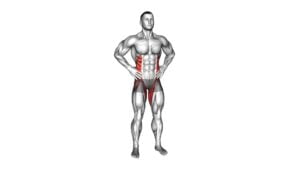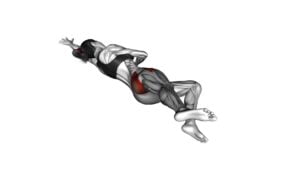Standing Side Leg Raise (female) – Video Exercise Guide & Tips

Looking to tone and strengthen your legs? The standing side leg raise is a great exercise for you!
Watch This Exercise Video
This video exercise guide will show you the proper form and technique, as well as modifications for all fitness levels.
Avoid common mistakes and maximize the effectiveness of this exercise with helpful tips.
Incorporate the standing side leg raise into your workout routine to achieve your fitness goals.
Get ready to feel the burn and see results!
Key Takeaways
- Standing Side Leg Raise improves balance.
- Standing Side Leg Raise tones glutes.
- Standing Side Leg Raise strengthens hips and glutes.
- Standing Side Leg Raise prevents injuries in the lower body.
Benefits of the Standing Side Leg Raise
You will experience numerous benefits from performing the Standing Side Leg Raise exercise. This exercise is highly effective in improving balance and toning your glutes. By regularly incorporating the Standing Side Leg Raise into your workout routine, you'll notice significant improvements in your overall balance and stability.
This exercise targets the muscles in your hips and glutes, helping to strengthen and tone them. As you raise your leg to the side, you engage the gluteus medius, which is responsible for stabilizing your hips and pelvis. Strengthening this muscle not only improves your balance but also helps prevent injuries, especially in the lower body.
Additionally, the Standing Side Leg Raise activates the gluteus maximus, the largest muscle in the buttocks. This helps to shape and lift your glutes, giving you a firmer and more toned appearance.
So, by incorporating the Standing Side Leg Raise into your workout routine, you can improve your balance and achieve well-toned glutes.
Now, let's move on to discussing the proper form and technique for this exercise.
Proper Form and Technique for the Exercise
To perform the Standing Side Leg Raise with proper form and technique, there are a few key points to keep in mind.
- Firstly, engaging your core throughout the exercise is crucial for stability and balance.
- Secondly, pay attention to your hip alignment, making sure to keep your hips stacked and not leaning forward or backward.
- Lastly, be aware of common form mistakes, such as lifting your leg too high or using momentum to swing it up.
Core Engagement Importance
Engage your core for proper form and technique during the Standing Side Leg Raise exercise.
Core engagement is crucial for maintaining stability and activating the necessary muscles during this exercise. By engaging your core, you create a strong and stable base to perform the movement effectively. This helps to prevent any excessive swaying of the body and ensures that the targeted muscles are being properly activated.
When your core is engaged, it also helps to protect your lower back from unnecessary strain or injury. To engage your core, imagine pulling your belly button towards your spine and maintaining this contraction throughout the exercise.
Hip Alignment Tips
Maintain proper hip alignment to ensure effective form and technique during the Standing Side Leg Raise exercise. Proper hip alignment is crucial for targeting the correct muscles and preventing injury.
To improve your hip alignment, focus on engaging your core muscles, specifically the muscles in your lower abdomen and lower back. This will help stabilize your pelvis and maintain a neutral spine position.
Additionally, pay attention to your leg position during the exercise. Make sure your standing leg is slightly bent and your toes are pointing forward. Avoid letting your hips drop or rotate during the movement.
By practicing hip alignment exercises and maintaining proper form, you can maximize the benefits of the Standing Side Leg Raise exercise.
Now, let's explore some common form mistakes to avoid.
Common Form Mistakes
Avoiding common form mistakes is essential for proper form and technique during the Standing Side Leg Raise exercise. By maintaining proper form, you can maximize hip stability and muscle activation, leading to a more effective workout.
Here are some common mistakes to avoid:
- Leaning your upper body: Keep your upper body straight and avoid leaning to the side. This ensures that the focus remains on your hip muscles.
- Swinging your leg: Control the movement of your leg throughout the exercise. Avoid swinging it up or down, as this reduces the effectiveness of the exercise.
- Lifting too high: Lift your leg to a comfortable height that allows you to maintain proper form. Lifting too high can strain your hip and lower back.
- Not engaging your core: Keep your core muscles engaged throughout the exercise. This helps with stability and prevents excessive strain on your lower back.
- Raising your leg too quickly: Lift your leg in a slow and controlled manner. This allows for better muscle activation and prevents momentum from taking over.
Modifications and Variations for All Fitness Levels
Now let's explore some modifications and variations for people of all fitness levels.
If you're just starting out, there are beginner-friendly modifications that can help you ease into the exercise.
On the other hand, if you're looking for a challenge, there are advanced variations that can push you to your limits.
Additionally, it's important to adapt the exercise according to your abilities to ensure a safe and effective workout.
Beginner-Friendly Modifications
Start with just a few repetitions of the standing side leg raise to gradually build strength and stability in your legs. As a beginner, it's important to listen to your body and adapt the exercise to your abilities. Here are some beginner-friendly modifications to help you get started:
- Start with a lower leg raise: Instead of lifting your leg all the way to the side, begin by lifting it just a few inches off the ground. As you get stronger, you can gradually increase the height of your leg raise.
- Use a chair for support: If you find it difficult to balance, place one hand on a chair or wall for support. This will help you maintain stability while performing the exercise.
- Decrease the range of motion: Instead of lifting your leg to the side, try lifting it diagonally forward or backward. This will still engage the muscles in your legs, but with less intensity.
- Perform the exercise on the floor: If standing is challenging, you can also do the side leg raise exercise while lying on your side. This will provide additional support and stability.
- Take breaks as needed: Don't push yourself too hard. Remember to listen to your body and take breaks whenever necessary.
Challenging Advanced Variations
To challenge yourself and continue progressing in your fitness journey, try incorporating advanced variations of the standing side leg raise exercise. These advanced modifications will help you target different muscle groups and push yourself further.
One advanced technique is to use ankle weights or resistance bands to add extra resistance to your leg raises. This will increase the intensity of the exercise and engage your muscles even more.
Another advanced modification is to perform the leg raises on an unstable surface, such as a balance board or a BOSU ball. This will require more stability and core strength to perform the exercise effectively.
By incorporating these advanced variations, you can continue to challenge yourself and improve your strength and balance.
Now, let's move on to adapting the exercise for different abilities.
Adapting for Different Abilities
Adaptability is key when modifying and varying the standing side leg raise exercise to accommodate individuals of all fitness levels. Here are some adaptations and progressions to consider:
- If you're a beginner or have limited mobility, you can start by performing the exercise while holding onto a sturdy chair or wall for support.
- To increase the difficulty, you can add ankle weights or resistance bands to challenge your muscles.
- If you find it difficult to balance, try performing the exercise while standing next to a wall or using a stability ball for support.
- For advanced individuals, you can incorporate variations such as lifting the leg higher, adding a knee lift at the top, or performing the exercise on an unstable surface like a balance board.
- Remember to listen to your body and progress at your own pace. It's important to find the right level of challenge without sacrificing proper form.
Common Mistakes to Avoid During the Exercise
Make sure to avoid these common mistakes during the standing side leg raise exercise. Proper form is crucial to maximize the benefits and prevent injuries. One common mistake is using momentum instead of controlled movements. Remember to engage your core and focus on lifting your leg using the muscles in your hip and outer thigh. Avoid swinging your leg or using jerky movements, as this can put unnecessary strain on your joints.
Another mistake to avoid is lifting your leg too high. While it may be tempting to push yourself, lifting your leg above hip level can compromise your balance and stability. Aim to lift your leg to a comfortable height where you can maintain proper form and control throughout the exercise.
Additionally, be mindful of your foot placement. Placing your foot too far forward or backward can affect the targeted muscles and diminish the effectiveness of the exercise. Keep your foot in line with your hip and maintain a neutral alignment.
Lastly, remember to breathe throughout the exercise. Holding your breath can increase tension and make the exercise more challenging. Inhale as you prepare and exhale as you lift your leg.
Tips for Maximizing the Effectiveness of the Standing Side Leg Raise
When performing the standing side leg raise, you can enhance the effectiveness of the exercise by incorporating these tips:
- Maintain proper balance: To maximize the benefits of the standing side leg raise, it's essential to focus on your balance. Keep your standing leg slightly bent and engage your core muscles to stabilize your body throughout the movement. This will help target the muscles in your outer thighs and hips more effectively.
- Increase flexibility: Flexibility plays a crucial role in performing the standing side leg raise correctly. Prioritize stretching your hip flexors and inner thighs before starting the exercise. This will allow for a greater range of motion and help prevent any strain or discomfort.
- Control the movement: Avoid swinging your leg up during the exercise. Instead, focus on controlled and deliberate movements. Lift your leg to the side, keeping it straight and in line with your body. Pause briefly at the top of the movement before slowly lowering it back down.
- Breathe properly: Remember to breathe throughout the exercise. Inhale as you lower your leg and exhale as you lift it. This will help oxygenate your muscles and provide them with the necessary energy to perform the exercise effectively.
- Gradually increase intensity: Start with a comfortable range of motion and gradually increase the height of your leg as you build strength and flexibility. Pushing yourself too hard too soon can lead to injury, so listen to your body and progress at a pace that feels challenging but manageable.
Incorporating the Standing Side Leg Raise Into Your Workout Routine
To incorporate the standing side leg raise into your workout routine, start by including it as a dynamic warm-up exercise. This exercise helps to activate and warm up the muscles in your legs, preparing them for the more intense exercises to come. Begin by standing with your feet hip-width apart and your hands on your hips. Lift one leg out to the side while keeping your body upright and maintaining a slight bend in the standing leg. Be sure to engage your core and keep your hips stable throughout the movement.
To further challenge yourself and increase the intensity of the exercise, you can incorporate resistance bands or add ankle weights. Resistance bands can be placed around your ankles or just above your knees to provide additional resistance as you lift your leg. Ankle weights can be strapped around your ankles to add extra weight, making the exercise more challenging. However, it's important to start with lighter weights and gradually increase the weight as you become stronger.
Incorporating resistance bands or adding ankle weights can help to strengthen and tone your leg muscles, particularly the glutes, hips, and thighs. Remember to always listen to your body and choose weights that are appropriate for your fitness level. By incorporating the standing side leg raise into your workout routine and gradually increasing the intensity, you can improve your overall lower body strength and stability.
Frequently Asked Questions
How Many Calories Does the Standing Side Leg Raise Burn?
The standing side leg raise is a great exercise for toning your outer thighs and hips. It targets the gluteus medius and minimus muscles, helping to improve your overall lower body strength and stability. When performed correctly, this exercise can also help improve your balance and coordination.
As for the number of calories burned, it depends on various factors such as your weight, intensity, and duration of the exercise. However, incorporating this exercise into your fitness routine can contribute to calorie burning and overall weight management.
Can the Standing Side Leg Raise Help Improve Balance and Stability?
The standing side leg raise can indeed help improve your balance and stability. By incorporating this exercise into your routine, you'll be able to strengthen your core and improve coordination.
This exercise specifically targets the muscles in your hips and glutes, which are crucial for maintaining balance. Regularly performing standing side leg raises can help you become more stable on your feet and enhance your overall balance and coordination.
Is It Necessary to Use Ankle Weights for the Standing Side Leg Raise?
Using ankle weights for the standing side leg raise isn't necessary, but it can add an extra challenge to your workout. It's important to start with lighter weights and gradually increase as you get stronger.
If you don't have ankle weights, don't worry! There are modifications you can do to still get the benefits of this exercise. Remember to listen to your body and choose the option that feels right for you.
Can the Standing Side Leg Raise Help Target Specific Muscles in the Legs?
The standing side leg raise can be a helpful exercise to target specific muscles in your legs. By lifting your leg to the side, you engage your outer thighs, glutes, and hip abductor muscles.
This exercise can improve your balance, stability, and overall lower body strength. To modify or vary the intensity, you can use ankle weights, perform the exercise on a stability ball, or add resistance bands.
Incorporating this exercise into your fitness routine can bring various benefits.
How Long Should I Hold the Raised Leg Position During the Exercise?
To improve flexibility and target specific leg muscles, it's important to know how long to hold the raised leg position during the exercise. Holding the position for about 5-10 seconds is a good starting point. This allows your muscles to engage and stretch properly.
However, be careful not to hold it for too long, as it may lead to muscle strain. It's also important to avoid common mistakes like leaning forward or using momentum to lift your leg.
Conclusion
Incorporating the standing side leg raise into your workout routine can provide numerous benefits for your lower body strength and stability. By maintaining proper form and technique, you can target your hip abductor muscles effectively.
Remember to avoid common mistakes and consider modifications to suit your fitness level. By following these tips, you can maximize the effectiveness of this exercise and achieve your fitness goals.

Author
Years ago, the spark of my life’s passion ignited in my mind the moment I stepped into the local gym for the first time. The inaugural bead of perspiration, the initial endeavor, the very first surge of endorphins, and a sense of pride that washed over me post-workout marked the beginning of my deep-seated interest in strength sports, fitness, and sports nutrition. This very curiosity blossomed rapidly into a profound fascination, propelling me to earn a Master’s degree in Physical Education from the Academy of Physical Education in Krakow, followed by a Sports Manager diploma from the Jagiellonian University. My journey of growth led me to gain more specialized qualifications, such as being a certified personal trainer with a focus on sports dietetics, a lifeguard, and an instructor for wellness and corrective gymnastics. Theoretical knowledge paired seamlessly with practical experience, reinforcing my belief that the transformation of individuals under my guidance was also a reflection of my personal growth. This belief holds true even today. Each day, I strive to push the boundaries and explore new realms. These realms gently elevate me to greater heights. The unique combination of passion for my field and the continuous quest for growth fuels my drive to break new ground.







